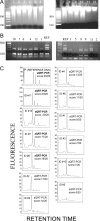DNA degradation test predicts success in whole-genome amplification from diverse clinical samples
- PMID: 17690213
- PMCID: PMC1975106
- DOI: 10.2353/jmoldx.2007.070004
DNA degradation test predicts success in whole-genome amplification from diverse clinical samples
Abstract
The need to apply modern technologies to analyze DNA from diverse clinical samples often stumbles on suboptimal sample quality. We developed a simple approach to assess DNA fragmentation in minute clinical samples of widely different origin and the likelihood of success of degradation-tolerant whole genome amplification (restriction and circularization-aided rolling circle amplification, RCA-RCA) and subsequent polymerase chain reaction (PCR). A multiplex PCR amplification of four glyceraldehyde-3-phosphate dehydrogenase amplicons of varying sizes was performed using genomic DNA from clinical samples, followed by size discrimination on agarose gel or fluorescent denaturing high-performance liquid chromatography (dHPLC). RCA-RCA followed by real-time PCR was also performed, for correlation. Even minimal quantities of longer PCR fragments ( approximately 300 to 400 bp), visible via high-sensitivity fluorescent dHPLC or agarose gel, were essential for the success of RCA-RCA and subsequent PCR-based assays. dHPLC gave a more accurate correlation between DNA fragmentation and sample quality than agarose gel electrophoresis. Multiplex-PCR-dHPLC predicted correctly the likelihood of assay success in formalin-fixed, paraffin-embedded samples fixed under controlled conditions and of different ages, in laser capture microdissection samples, in tissue print micropeels, and plasma-circulating DNA. Estimates of the percent information retained relative to snap-frozen DNA are derived for real-time PCR analysis. The assay is rapid and convenient and can be used widely to characterize DNA from any clinical sample of unknown quality.
Figures







References
-
- Lewis F, Maughan NJ, Smith V, Hillan K, Quirke P. Unlocking the archive—gene expression in paraffin-embedded tissue. J Pathol. 2001;195:66–71. - PubMed
-
- Shibata D. Extraction of DNA from paraffin-embedded tissue for analysis by polymerase chain reaction: new tricks from an old friend. Hum Pathol. 1994;25:561–563. - PubMed
-
- Emmert-Buck MR, Bonner RF, Smith PD, Chuaqui RF, Zhuang Z, Goldstein SR, Weiss RA, Liotta LA. Laser capture microdissection. Science. 1996;274:998–1001. - PubMed
-
- Gaston SM, Soares MA, Siddiqui MM, Vu D, Lee JM, Goldner DL, Brice MJ, Shih JC, Upton MP, Perides G, Baptista J, Lavin PT, Bloch BN, Genega EM, Rubin MA, Lenkinski RE. Tissue-print and print-phoresis as platform technologies for the molecular analysis of human surgical specimens: mapping tumor invasion of the prostate capsule. Nat Med. 2005;11:95–101. - PubMed
-
- Anker P, Mulcahy H, Chen XQ, Stroun M. Detection of circulating tumour DNA in the blood (plasma/serum) of cancer patients. Cancer Metastasis Rev. 1999;18:65–73. - PubMed
Publication types
MeSH terms
Substances
Grants and funding
LinkOut - more resources
Full Text Sources
Other Literature Sources
Research Materials
Miscellaneous

